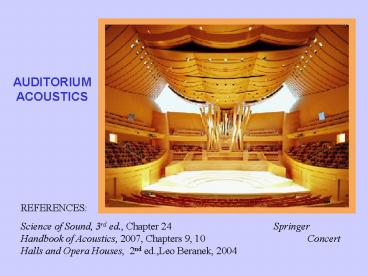AUDITORIUM ACOUSTICS - PowerPoint PPT Presentation
1 / 27
Title: AUDITORIUM ACOUSTICS
1
AUDITORIUM ACOUSTICS
REFERENCES Science of Sound, 3rd ed., Chapter 24
Springer
Handbook of Acoustics, 2007, Chapters 9, 10
Concert Halls
and Opera Houses, 2nd ed.,Leo Beranek, 2004
2
SOUND FIELD OUTDOORS AND INDOORS
p vs r
log p vs log r
- Free field
Reflections
3
DIRECT AND EARLY SOUND
SOUND TRAVELS AT 343 m/s. THE DIRECT SOUND
REACHES THE LISTENER IN 20 to 200 ms, DEPENDING
ON THE DISTANCE FROM THE SOURCE TO THE
LISTENER. A SHORT TIME LATER THE SAME SOUND
REACHES THE LISTENER FROM VARIOUS REFLECTING
SURFACES, MAINLY THE WALLS AND THE CEILING. THE
FIRST GROUP OF REFLECTIONS, REACHING THE LISTENER
WITHIN ABOUT 50 to 80 ms, IS OFTEN CALLED THE
EARLY SOUND. EARLY REFLECTIONS FROM SIDE WALLS
ARE NOT EQUIVALENT TO EARLY REFLECTIONS FROM THE
CEILING OR FROM OVERHHEAD REFLECTORS. IF THE
TOTAL ENEERGY FROM LATERAL REFLECTIONS IS GREATER
THAN THE ENERGY FROM OVERHEAD REFLECTIONS, THE
HALL TAKES ON A DESIRABLE SPATIAL IMPRESSION.
4
PRECEDENCE EFFECT
RATHER REMARKABLY, OUR AUDITORY PROCESSOR DEDUCES
THE DIRECTION OF THE SOUND SOURCE FROM THE FIRST
SOUND THAT REACHES OUR EARS, IGNORING
REFLECTIONS. THIS IS CALLED THE PRECEDENCE
EFFECT OR LAW OF THE FIRST WAVEFRONT. THE
SOURCE IS PERCEIVED TO BE IN THE DIRECTION FROM
WHICH THE FIRST SOUD ARRIVES PROVIDED THAT 1.
SUCCESSIVE SOUND ARRIVE WITHIN 35 ms 2.
SUCCESSIVE SOUNDS HAVE SPECTRA AND ENVELOPES
SIMILAR TO THE FIRST SOUND 3. SUCCESSIVE SOUNDS
ARE NOT TOO MUCH LOUDER THAN THE FIRST
5
GROWTH AND DECAY OF REVERBERANT SOUND
SOUND SOURCE
SOUND AT LISTENER
6
GROWTH AND DECAY OF REVERBERANT SOUND
RT K (volume / area) RT 0.161 V/A (V in m3
A in m2 ) If room dimensions are given in feet,
the formula may be written RT 0.049 V/A (V
in ft.3 A in ft.2 )
7
SOUND DECAY
Sound decay
Sound decay in a 400 m3 classroom
Sound pressure level as a function of time for
that room
8
DECAY OF REVERBERANT SOUND
9
CALCULATING REVERBERATION TIME
10
CALCULATING REVERBERATION TIME
11
CRITERIA FOR GOOD ACOUSTICS
ADEQUATE LOUDNESS UNFORMITY CLARITY REVERBERANCE F
REEDOM FROM ECHOES LOW LEVEL OF BACKGROUND NOISE
12
Desirable reverberation times for various sizes
and functions
Variation of reverberation time with frequency in
good halls
13
Avery Fisher Hall (New York)
14
McDermott ConcertHall (Dallas)
15
Orchestra Hall(Chicago)
16
MeyerhofSymphony Hall(Baltimore)
17
Walt Disney Concert Hall
18
Disney
19
(No Transcript)
20
Kimmel Center Auditorium (Philadelphia)
21
BACKGROUND NOISE CRITERIA
22
Important criteria for concert halls
- Spatial impression
- Intimacy
- Early decay time
- Clarity
- Warmth
23
Concerthallsthroughoutthe World
24
CHURCHES
CHURCHES AND SYNAGOGUES ARE NOT PRIMARILY CONCERT
HALLS, BUT THEY SHARE MANY OF THE SAME
REQUIREMENTS FOR GOOD ACOUSTICS OLD CATHEDRALS
HAVE LONG REVERBERATION TIMES, AND THE SPOKEN
WORD IS NOT AS IMPORTANT AS IN CONTEMPORARY
WORSHIP. MUCH ORGAN MUSIC WAS COMPOSED FOR THESE
SPACES BACKGROUND NOISE SHOULD BE VERY
LOW ELECTRONIC REINFORCEMENT OF SOUND SHOULD BE
USED ONLY WHEN NECESSARY!
25
CLASSROOMS
NEED FOR GOOD ACOUSTICS STUDENTS MUST BE ABLE TO
UNDERSTAND THE TEACHER AND EACH OTHER MUST
CONROL REVERBERATION HEATING, VENTILATION,
AND AIR CONDITIONING NOISE FROM OUTSIDE THE
CLASSROOM ANSI STANDARDS NC-25 to NC-30
26
WALLS AND NOISE BARRIERS
The transmission coefficient is the ratio of
transmitted to incident intensity t IT/I0
and the transmission loss is TL -10 log t. At
low frequency, the sound transmission loss
follows a mass law, increasing with increasing
frequency and mass density M of the wall
Transmission loss for a wall may fall below that
predicted by the mass law, due to any of the
following 1. Wall resonances 2. Excitation of
bending waves at the critical frequency where
they travel at the same speed as certain sound
waves in air 3. Leakage of sound through holes
and cracks
27
TRANSMISSION LOSS
THE EFFECT OF A HOLE ON TRANSMISSION LOSS































